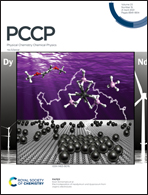Evaluation of Ar tagging toward the vibrational spectra and zero point energy of X−HOH, X−DOH, and X−HOD, for X = F, Cl, Br†
Abstract
In this study, we theoretically evaluated the effect of argon tagging toward the binding energy and vibrational spectra of water halide anion complexes Ar.X−HOH, Ar.X−HOD, and Ar.X−DOH (X = F, Cl, Br). The ionic hydrogen bond (IHB) OH stretching mode was calculated to have a strong peak in the vibrational spectra, and coupling to intermolecular modes as well as bending modes was observed as combination bands and Fermi resonances. We found that the argon tagging affected the IHB OH stretching peak position in Ar.F−H2O, but not in Ar.Cl−H2O and Ar.Br−H2O. Furthermore, D-binding is favored for Cl and Br based on zero point energies, but for F our calculated zero point energies did not show a preference between H- and D-binding. We show that the competition of the energy lowering in the zero point energy of the anharmonic IHB OH (OD) stretching mode versus the intermolecular out-of-plane IHB OH (OD) wagging mode is important for determining the preference between H- and D-binding for these monohydrated halide clusters. We also found that for X−HOD the HOD bending fundamental peak is blue shifted compared to bare HOD, but is redshifted for F−DOH.



 Please wait while we load your content...
Please wait while we load your content...